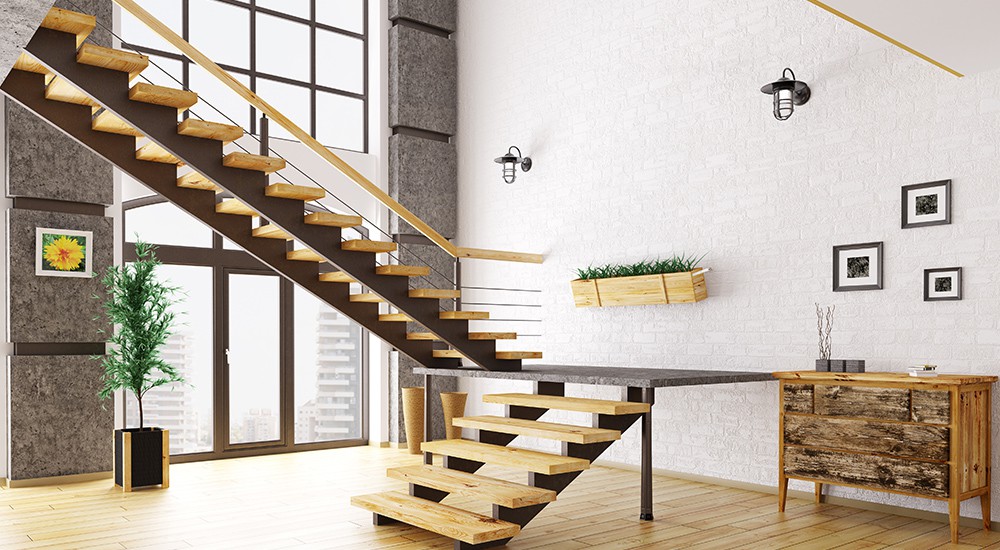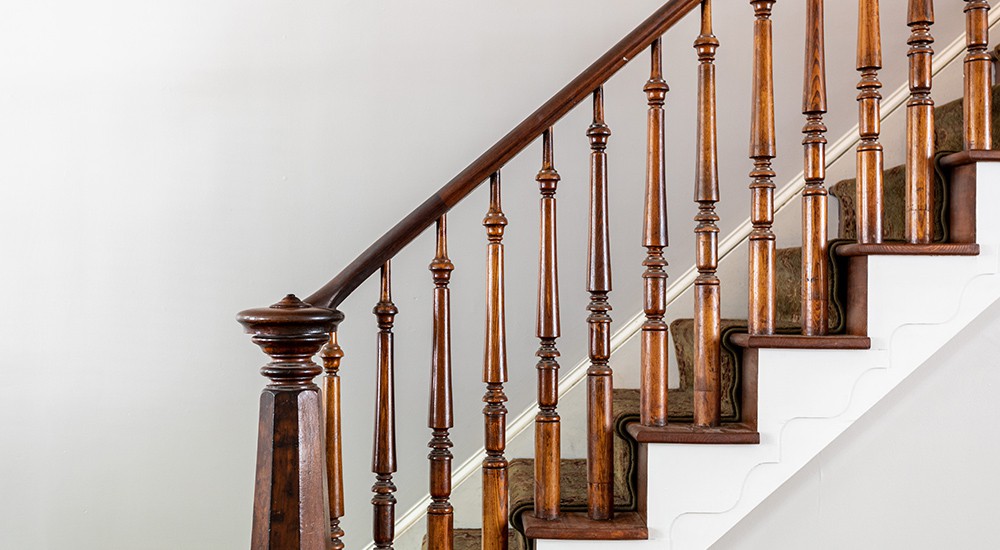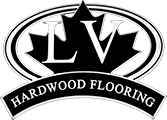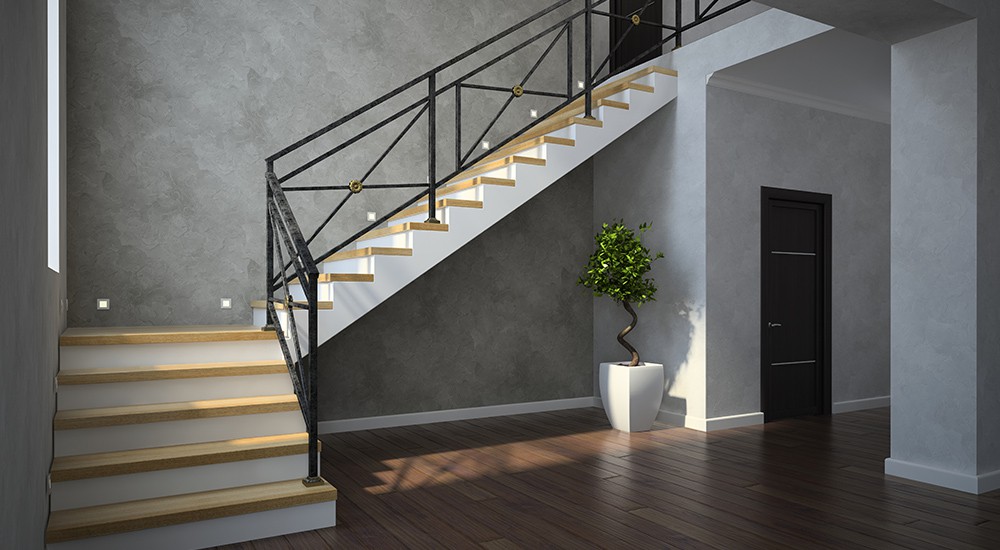Wooden stairs aren’t just for traditional homes. Contrary to popular opinion, a wooden stair can fit a modern home’s theme. With ideas for wooden stairs parts, you can create custom stairs to suit your home.
Wooden stairs are easy to maintain and are cost-effective. In addition, they add life to your home’s interior, making it look more attractive. If you’re looking for something classy, you can combine wood with other materials. Also, you can decide to paint your wooden stairs to change the look.
Choosing the best design for wood stairs can be quite difficult. There are lots of designs to choose from, making it even harder to decide. That’s why we’re discussing the top ideas for wooden stairs. Let’s start by discussing the best type of wood for wooden stairs.
Best Wood for Wooden Stairs
Woods range from oak to pine to walnut, all of which are perfect for your home. Likewise, dark hardwood, which has a striking resemblance to mahogany, is ideal for your home. Typically, hardwood and softwood are brilliant choices of wood types for your stairs. However, they differ in appearance, cost and preference.
Here are the different types of hardwood and their benefits:
White oak
One popular hardwood people use for stair parts is white oak. It’s tough and has a high resistance to dents or scratches. You can easily recognize oak hardwood by its unique tiger stripe.
The most common idea for wooden stairs that incorporates oak hardwood is the oak spindle. Also, you can use oak newel posts which have a wide range of designs for your wooden stairs.
Oak hardwood is known for its longevity and robust appearance. It has a natural and classy feel to it making it ideal for traditional houses. White oaks are more water-resistant and heavier than softwood.
Walnut

Walnut is just as strong and heavy as white oak hardwood. It’s easy to work with and has been in use for years in making furniture. When you use walnut with other wood products, the results are often great. You’ll also love the dark colour because it masks stains.
Sapele
Sapele shares close characteristics, both visual and working, with mahogany. Like mahogany, Sapele undergoes the same processing and has the same internal characteristics. Furthermore, it has an exotic and dramatic look making it ideal for a stair railing design. You can polish or finish your Sapele wood to give it a lustrous look.
Other examples of hardwood that are ideal for stair parts are:
- Ash
- White primed wood
- Birch
- Poplar
- Maple
One advantage of using hardwood for stair parts is that it’s more durable than softwood. With hardwood, you’re less likely to have your stair parts wear out easily. Also, you can hide scratches from pet paws or children well. Buying hardwood stair parts is a good long-term and high-quality investment.
Away from hardwood, you can get softwood from a coniferous tree. Typically, softwoods, unlike hardwood, have lower densities. Also, they are ideal if you’re in search of a low-budget idea for wooden stair parts. One advantage of softwood is that they are less prone is that it’s more readily available than hardwoods.
In addition, softwoods give you more freedom in terms of designs as you can easily paint them. Also, they are very compatible with finishing types. You can find softwood in various locations. Examples of softwood are,
Pine
One benefit of using pine softwood for your stairs’ treads is its affordability. Also, pinewood is readily available, allowing you easily get a good one within your budget.
Likewise, pine accepts paint and stain. You can stain your pine stair treads with a light or clear finish. To get even darker stains, apply more coats of stains. In addition to treads, you can use pine for your stairs risers.
Hemlock
If your home has a traditional setting, hemlock wooden stair parts will be perfect. Hemlock gives your home a classic touch as it’s not as brittle as other softwoods. Also, it allows for painting, takes stain easily and gives a perfect finish. You can opt for contemporary or modern hemlock stairs design if your home isn’t traditional.
Hemlock has a straight-grained feel which varnishes to a beautiful golden colour. Unlike other softwoods, hemlock hides stains well owing to its colour distortion.
The best part of emlock is that it’s unlikely to twist, cup or check. It’s affordable yet versatile, making it a good idea for wooden stairs parts.
Ideas for Wooden Stairs Parts
A properly designed staircase is a home’s signature look. The quality and style of the stairs can either reduce or increase your home’s aesthetic appeal. Therefore, it’s not a surprise that wooden stairs are a more preferred stairs option. Wood is renowned for its natural look, quality and durability.
Wooden stairs commonly feature several parts. The parts help in enhancing the aesthetics and improving the overall look. Here are the top ideas for wooden stairs parts.
Treads
Treads can be briefly described as the flat and horizontal slabs we walk on. Without treads, it’ll be impossible to go up or down the stairs. Also, between these treads are vertical pieces called risers.
It’s best to build your stair treads to be heavily reinforced and strong. The reason is that treads have to endure high foot traffic. Also, wood strength is another important factor to consider when selecting treads.
If hardwood is among your home’s interior designs, we advise you select treads that blend perfectly. There are options of using white oak or walnut for building treads. With treads, you should always go for aesthetics over strength.

Turnout
Using turnouts in your stairs is a unique way to begin your stairs. Although they aren’t as dramatic as volutes, turnouts are very much attractive. There are two types of turnouts namely the right and left hand turnout. Additionally, turnouts must feature pin-top newel posts below its entire structure.
Typically, turnouts are available in different types of woods. These woods include hickory, alder, hard maple, red oaks, or American cherry.
One of the distinguishing features of turnouts is they’re often made of clear woods. Clear woods are woods without any form of blemishes or knots. You can use turnouts to complete the bottom of your stairs railing. You can also use a turnout on curved stairs or straight ones.
Newel posts
Newel posts are usually very sturdy. You can find newel posts at the top, landings or the bottom of any stairs. In addition, they function by acting as anchors for your stairs handrails.
While providing anchors, newel posts provide strength and rigidity to the entire staircase design. Nowadays, it’s not unusual to see a cap on top of a newel post. Also, you can go for a modern design idea for wood stairs parts or an ornate one.
Newel posts are joined to the stairs handrails. Therefore, both newel posts and your handrails mustn’t have contrasting materials.
Balusters
The parts of wooden stairs that are erect between posts are called balusters. Installers typically attach balusters to handrails and stairs treads.
Wooden balusters are available in different designs, giving you a variety of options. Common design ideas for wood stairs balusters include traditional and orange or simple to straight.
Balusters aren’t prone to wearing out easily compared to treads. The implication of this is that you can make balusters using solid hardwood. However, the choice of using either wood or iron balusters entirely depends on you.
Gooseneck
Goosenecks are vertical handrails that join sloped handrails to another handrail on your stairs landing. A gooseneck also connects handrails on the balcony. While goosenecks are available in various sizes and shapes it’s best to purchase parts that match your handrail.
You can use goosenecks to change directions on your stairs handrail. They’re also useful on the floor or a landing.
Stair risers
Stair risers are the vertical parts of wooden stairs that create space and height between each tread. Stair risers are closely related to stair treads. The reason is, builders are to consider the relationship between the run and the rise of the stairs.
Handrails
Handrails are the stairs part where you rest your hands as you descend or ascend the stairs. Handrails are usually round-shaped to allow you to rest your hand comfortably. Your handrail can be traditional or modern, depending on your home’s interior design.
Stair stringers
Another idea for wooden stairs parts is stair stringers. Stair stringers shoulder the whole responsibility of ensuring each side of the stairs is secure. Therefore, while stair stringers are mostly attractive, they should also be durable.
Rosette
If you don’t use a half-newel at the point where a handrail ends in your wall, you can use a rosette. Rosettes are optional decorative wooden stair parts. Rosettes are an added ornament or an aesthetic detail. They make attaching a handrail to the wall an easy process.
If your baluster has a traditional appearance, rosettes are capable of adding a fashionable detail. However, if you desire a more contemporary look, you can try alternative ideas for wooden stairs parts.
Related Article: How Much Do Hardwood Stairs Cost?
Factors to Consider when Choosing Stair Railings Design

From your home space to your preferred wooden material, these factors can impact your choice of wooden stairs parts. Before you buy wood stair parts, you have to consider your family’s needs.
For instance, a family with a senior citizen may have to make the stairs easy to climb. Likewise, if there’s a baby in the house, the stairs have to be safe enough for the baby.
A budget is of utmost importance when choosing a stair railing design. Thankfully, you can buy stair parts in Ontario without breaking the bank. You can also go for exotic woods like oak if your budget is flexible.
Here’s a detailed description of factors to consider when choosing stair railings design.
Building regulations
It’s important that you check the building regulations in your area before beginning a staircase remodelling project. If you’re unsure about your area’s building regulations, make enquiries from a professional. Your area’s building regulations can determine things like the pitch, height, depth and size of your staircase.
In most states, using a handrail for the whole length of your stairs is compulsory. Likewise, most states’ building regulations include stairs, balusters, banisters and newel posts.
Railing and its components
When selecting a railing for your wooden stairs, you must first establish the post, handrail and picket designs. Furthermore, it’s best to decide on which installation method to use before proceeding.
Typically, many homeowners use the post to post layout. The post-to-post layout is a standard railing layout and is common in many homes.
Additionally, you can request a continuous layout if you’re seeking something other than the standard railing layout. You can further discuss with your installer about other available layout options.
Your space
If you’re working with a small space, be sure to keep in mind appropriate designs. Usually, it’s best to go for ideas for wooden stairs that don’t take up space. Likewise, if you have enough room to work with, you can go for a grand staircase.
Straight stairs usually occupy more space downstairs than upstairs. In the room above, straight stairs only take up a long and thin rectangular opening. You can consider straight stairs if the room below is spacious.
Furthermore, for smaller spaces downstairs, spiral stairs are ideal. It only consumes a small space in the room below but needs a circular or square opening in the room above.
Spiral stairs design for wood stairs may require a lot of space in the room above. You can always push your spiral stairs to a corner of the room, allowing you to do more with your space.
A combination of spiral and straight treads is another unique way of designing your stairs. If the opening for the spiral stairs isn’t suitable, consider a mixed stair. That way, you can maximize the space you have and still get your spiral stairs.
Budget
A budget is a major factor when choosing the best idea for wooden stairs parts. The kind of materials your stairs parts will need, and its style depends on your budget. For instance, you can combine wood and glass for your stairs, depending on your budget. Also, for a more cost-effective budget, you can combine wood and metal for your stairs.
However, you can’t fully come up with a budget without getting quotes from a professional. Therefore, we recommend you get in touch with a professional and discuss your options. Doing this will determine if the budget you have is sufficient for your desired stair railings design.
Occupants’ safety
A stair is likely to have lots of foot traffic. Owing to this, you should only use the best materials for your stairs. Also, building regulations state that stairs shouldn’t have gaps more than 100mm. The required gap width ensures that children can’t climb through any baluster.
Additionally, if senior citizens occupy the house, the stairs should have handrails and landing plates. You should ensure that the materials used in making the wooden stairs are anti-slip in case of spills. Spiral staircases aren’t dangerous as many think and are safe for children.
Related Article: How to Install Hardwood Stairs
To Sum It Up
Your stairs are an important part of your home’s interior décor. Stairs are capable of leaving a strong impression on your guests. Also, owing to their importance, you should only make your wood stairs parts with the best materials. Doing so will help them withstand wear and tear over the years.
Various ideas for wooden stairs parts can help give your home a distinct look. With custom parts made from the finest materials, your stairs will speak class and quality.
Getting the best quality for your stairs parts doesn’t have to be a hassle. At LV Flooring, our stairs parts are made only from the finest materials. We provide quality stairs parts for both indoor and outdoor stairs. Check out our online store for different stairs parts in varying designs today!


